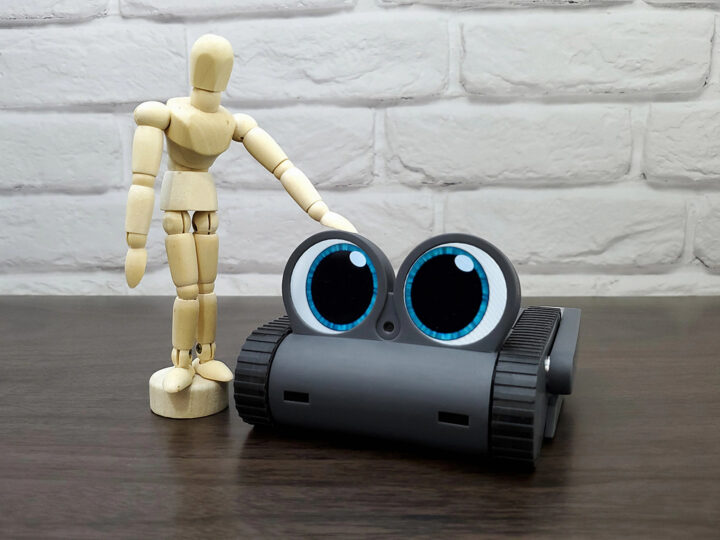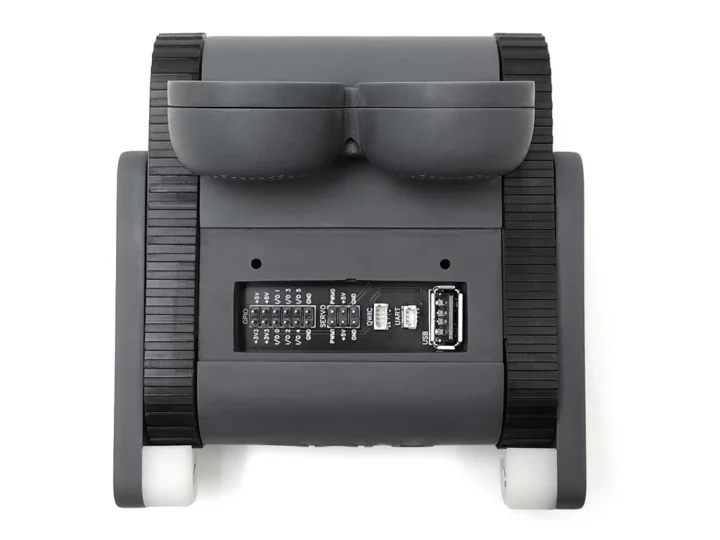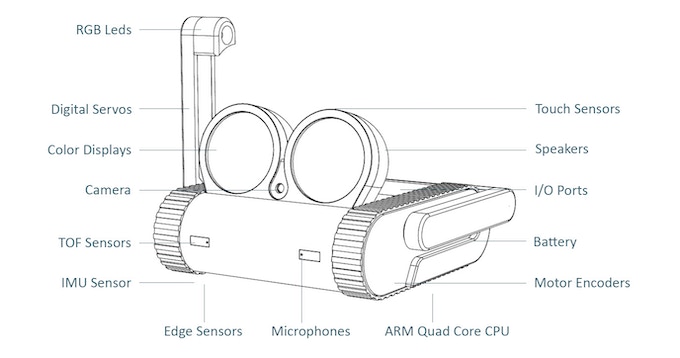Limitbit Doly is a cute little autonomous robot with two continuous tracks, two small arms controlled by servos, two round color displays acting as the eyes, and various sensors, all controlled by a Raspberry Pi CM4 system-on-module.
The robot can be used for STEM (Science, Technology, Engineering, and Mathematics) education or as a developer platform. AI workloads can also run on the Raspberry Pi CM4 module taking sensors, camera, and microphone inputs, with the robot interacting with the user through the built-in stereo speaker and two eyes. In practice, that means Doly supports features such as face recognition and smart audio with the robot capable of recognizing its owner and responding to voice commands.
Doly specifications:
- System-on-Module – Raspberry Pi CM4 Lite model CM4101000 (1GB RAM, Wireless) by default, but also supports other CM4/CM Lite modules with wireless
- Storage – MicroSD card slot
- Display – 2x high-resolution color displays (the two eyes)
- Camera – 8 MP wide-angle camera
- Audio – 2x microphones, 2W stereo speakers
- USB – 1x USB Type-A port
- Motor control
- 2x servo motors for arms
- 2x metal gear motors for the continuous tracks
- 2x hi-res encoders
- Sensors
- 2x touch sensors (so you can pat the robot like you would with a cat or dog)
- 2x ToF sensors for ranging
- 6-axis IMU sensor
- 4x IR edge Sensors
- Expansion for add-ons such as an additional robot arm
- 12x header with 6x GPIO pins, power signals
- 6-pin header with 2x servo outputs
- 1x Qwiic I2C connector
- 1x UART connector
- Misc – 2x RGB LEDs
- Power Supply
- Input – 5V DC & 3.3V DC
- Battery – 2,600 mAh battery good for about two hours
- Dimensions – 110 x 114 x 68 mm
Doly is said to be “fully open-hardware, open-design and 3D-printable”, but the company is being honest as they also mention that “while our hardware is open for community use, it’s important to note that we don’t completely align with the Open Source Hardware Association (OSHW) philosophy.”, which I understand as “some bits and pieces will be closed-source”.
No actual software resources have been shared right now because it’s a crowdfunding campaign, but Limitbit does provide some information about the software for Doly
- The CM4 runs a Linux-based OS, unsurprisingly…
- It can be programmed with Blockly visual programming IDE, as well as C, C++, and Python.
- The Python-based Doly SDK will provide API to retrieve sensor data (camera, ToF, edge sensor…) and some AI data (face recognition, emotion,..), and to control the motors, servos, and displays (e.g. Eye customize controls).
- While the Raspberry Pi robot can be interacted with in autonomous mode, the company will also provide the Dolby mobile app for Android and iOS, as well as a Windows program to control the robot remotely as an FPV (first-person view) vehicle.
You’ll get an idea of what the Doly robot is capable of in the video embedded below.
Limitbit has recently launched the Doly robot on Kickstarter and easily surpassed its ~$6,000 funding target with over $130,000 raised so far thanks to pledges from over 400 backers. Rewards start at $269 for the “3D Maker Edition” with all the electronics minus the Raspberry Pi CM4 module and no plastic parts that can be 3D printed by the user. I’d expect most people to go with the $299 reward for a fully assembled Doly robot including a Raspberry Pi CM4 Lite module with 1GB RAM and WiFi. Prices do not include shipping which will be calculated once Limitbit is ready to ship rewards to backers in August 2024 if everything goes according to plans…
Thanks to TLS for the tip.

Jean-Luc started CNX Software in 2010 as a part-time endeavor, before quitting his job as a software engineering manager, and starting to write daily news, and reviews full time later in 2011.
Support CNX Software! Donate via cryptocurrencies, become a Patron on Patreon, or purchase goods on Amazon or Aliexpress







